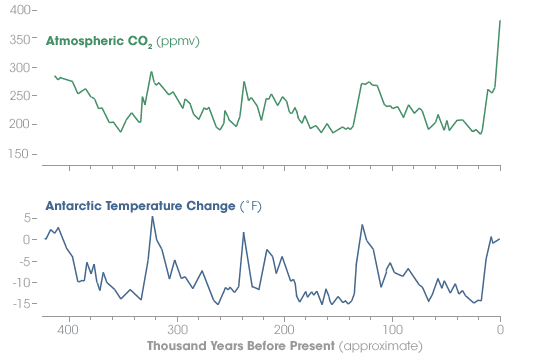

Canaries in the Coal Mine |
|||
According to Bindschadler, NASA’s new satellite technology is helping scientists rewrite the textbooks on ice sheet dynamics. Until recently, most glaciologists believed ice streams require decades, if not centuries, to start and stop. But new data reveal they can start and stop in a matter of seconds. Moreover, conventional wisdom held that the bottoms of ice shelves could melt no faster than 1 to 2 meters per year. But Eric Rignot, of NASA’s Jet Propulsion Laboratory, proved recently that ice shelves can lose tens of meters of ice thickness per year due to melting on the bottom. This discovery is particularly concerning to Bindschadler and his colleagues. Because ice shelves already float in the ocean, their melting cannot significantly influence sea level. (To test this fact, place a handful of ice cubes in a glass and then fill it with water. Just as the water level in the glass does not change as the ice cubes melt, global sea level does not change significantly as ice shelves melt.) However, cautions Bindschadler, ice shelves such as those around Antarctica are important because they buttress the much larger ice sheets poised on land. Removal of any of the continent’s ice shelves would likely accelerate the flow rate of ice streams off the land and into the ocean, which would in turn raise sea level. Antarctica’s ice shelves are massive structures that have remained largely intact for many thousands of years. How quickly could they change? “The Larsen Ice Shelf is the poster child for this phenomenon,” Bindschadler says ominously. “It has three major sections—A, B, and C. Most of the Larsen B Ice Shelf collapsed in just two days, and no one saw it coming.” Scientists knew the Larsen Ice Shelf was thinning and retreating. But in March 2002 they were stunned to see most of the 2,000-square-kilometer shelf disintegrate so suddenly. And sure enough, Bindschadler and his colleagues see an increased flow of ice off the land where the Larsen B shelf used to be. Even more disturbing is the fact that other Antarctic ice shelves are showing signs similar to the Larsen just before it collapsed. ICESat data show that many of Antarctica’s major ice shelves are thinning, making them increasingly prone to forming cracks and crevasses due to temperature changes and tidal cycles. In the summertime, melt water on the surface seeps down into the cracks, helping them to grow larger and deeper. Because water is heavier than ice, enough water can continue the process, driving cracks completely through the shelf. All that’s left is for the tall, thin slabs of ice to fall over in the water, like a pack of standing dominoes. Scientists suspect this is what happened to Larsen B. Data records reveal that our world’s southern continent has warmed by 2.5 degrees Celsius (4.5°F) over the last 50 years, making it one of the fastest-warming places on the planet. Over the last 25 years, Bindschadler and his colleagues have learned that Earth’s ice sheets are much more responsive to global warming than they used to think. “The picture that is emerging is increasingly disturbing,” Bindschadler states. |

In the largest single disintegration event in 30 years of ice shelf monitoring, approximately 3,250 square kilometers of the Larsen B shattered in 2002. The disintegration released 720 billion tons of ice into the Weddell Sea. (Images courtesy of the National Snow and Ice Data Center) |
||
 |
|||
In a global-warming scenario, scientists expect to see changes happening most noticeably and most rapidly in the polar regions. Specifically, they expect to see ice streams accelerating, more icebergs calving, and ice sheets thinning. On Greenland, and in other areas around the Arctic Circle, they expect to see earlier break-ups of sea ice packs in the spring, prolonged growing seasons, increased plant growth, thawing permafrost in the soils, shrinking glaciers, and more freshwater runoff into the ocean. “And we do see all of those things!” Bindschadler concludes. “You might say ice sheets are the ‘canaries in the coal mine’ of climate science. And right now the canaries are chirping an alarm.” Bindschadler pauses and then qualifies that last statement. “We can’t be certain something cataclysmic is going to happen. I’m saying the fundamental physics that control ice sheet conditions certainly allow something cataclysmic to happen, and that changes are happening at an accelerating rate. There’s ample reason to be concerned.”
|
Comparison of carbon dioxide (green line) content in the atmosphere over the last 400,000 years with surface temperature (blue) during the same period reveals that these two measurements are very closely correlated over time. As atmospheric carbon dioxide concentrations rise and fall, so does temperature. Today, humans have driven up the concentration of carbon dioxide to about 380 parts per million—a value much higher than our world has seen in more than half a million years. (Graph derived from data extracted from an ice core recovered from the Vostok Station in Antarctica) |
||